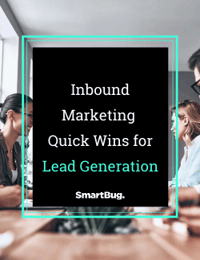
Inbound Marketing: The Biggest Shifts Happening in Marketing Strategy
January 18, 2021
If 2020 taught us anything at all, it’s that strategic planning and preparation is key. No one could have predicted what would happen in 2020 (unless you’re able to glimpse into the future, in which case a little warning would have been nice).
Businesses were forced to jump into remote work, and some of us were able to offer guidance on the ins and outs of working from your kitchen table with dogs barking at the Amazon truck in the background. Digital transformation went from a slow and steady walk to a 100-yard sprint for a lot of companies, e-commerce skyrocketed, search engines flooded with information overload—not to mention that our lives were all affected and we began to think a little differently.
This article isn’t about discussing the crazy year that just passed, but instead it deals with thinking strategically about how our businesses can grow and prosper in the coming year, focusing on inbound and demand gen strategies.
Build an all-inclusive inbound marketing engine.
On our blog, we’ve gone through some of SmartBug®’s best predictions for what to look out for in 2021, covering everything from top ABM priorities to customer advocacy. Now we’re on to the fun part (in my personal marketing nerd opinion): inbound marketing.
If you’re familiar with inbound marketing, you know that it’s a slow and steady race that includes incremental work that will build up over time. In this article, I will be discussing some of my favorite inbound and demand gen strategies to incorporate into your 2021 marketing plan.
One of the biggest shifts I have seen in the industry is creating highly targeted multi-channel campaigns that leverage one another and speak to the human reading it, not the bot crawling the page. Read on and discover how each piece of the puzzle can fit together to create an inbound campaign that will drive results.
Start with a solid foundation: your website.
Just like building a house, a solid Intelligent Inbound® strategy starts by building the proper foundation. If your website isn’t set up for inbound marketing, it’s going to make grabbing new contacts rather difficult (but pretty please, do not purchase lists, they will not help you). Taking the time to invest in your website will allow you to achieve the best results.
So, what does a proper website look like? In super-simplistic terms, it needs to:
- Be visually appealing to the eye (think user experience, or UX)
- Have small page sizes for fast load times
- Incorporate proper conversion paths
- Include highly visible and engaging calls to action (CTAs)
- Have a resources center for all of your blogs, e-books, webinars, and so forth
Utilize forms throughout, making it easy for your website visitor to ask for more information.
Create meaningful content: Talk to a human, not a robot.
One of my greatest takeaways from 2020 seems rather simple: Create content that a human wants to read.
I could go on for days about the types of content we can create—e-books, guides, FAQs, blogs, checklist and so much more—like I said, I could go on forever. But what matters most is creating content that your website visitors are actually interested in learning more about. It’s always important to imagine yourself being in their shoes and create content centered around what they would want to read.
Have you ever read a blog and halfway through you see words sandwiched like, “foundation, build, strategic marketing, plans 2021,” and you think, “What did I just read?!” Keyword stuffing is not only frowned upon by search engines, it also just flat-out doesn’t make sense to the reader.
The days of creating content for search engines is over. Sure, you should have a strong keyword strategy, but focus more on the human you’re trying to speak to and their pain points, rather than stuffing keywords in 15 places throughout your blog article.
Leverage a vertical strategy.
So, you sell the coolest lion paintings on the market, but you also have some pretty stellar paintings of tigers, and you’re starting to dabble in bears—oh my, that’s a lot of different products to market. Instead of trying to tie all of your products into one marketing strategy, leverage your new personas, and create strategic marketing campaigns focused on one product at a time.
Have some fun with email.
Some businesses think that email marketing is a strategy of the past. Well, news flash, it’s not. According to Business 2 Community, 46.9 percent of businesses plan to send more emails to customers than they did pre-COVID-19. Email marketing allows you to leverage a different platform, other than just your website, to get your message across. Why not give it a try and be snazzy with it? We love incorporating an emoji or two.
Create that content offer promoting your new service offering, include CTAs in your email, and get that viewer to request a demo via the form on your landing page. Bam—you’re one step closer to creating an all-inclusive inbound marketing campaign.
Don’t forget about social media.
Remember what I said about talking to a human? Well, HubSpot agrees that many businesses are focusing on creating less, but more meaningful, content in 2021. One strategy I will be relying on heavily in 2021 is to create personal, individualized content for each social media platform. After all, what human would follow you on LinkedIn, Facebook, and Twitter to read the exact same message on each platform? Every social media platform is unique, and your content should follow suit. Instead of trying to push out 15 Tweets per day, focus on creating one meaningful piece that drives conversions.
Your social media should serve a purpose: to showcase you as a thought leader in the industry by sharing evergreen content on industry news, as well as pushing out thought leadership content your organization creates. This drives people to your website, to a landing page, to fill out a form, and ... you get it.
Remember that video content is king.
With the emergence of TikTok, and many social media platforms trying to copy its success, video marketing has soared in the past year—with no signs of looking back. Whether you’re a B2B or B2C organization, you can leverage video in your content in a variety of ways, including posting on social media, on your website through VidYard (you can even measure engagement with this tool), and much more.
Tying video—whether it’s a one-minute explainer video about who you are and what stands you apart, or a live webinar with industry experts—video can and should be incorporated into your inbound and demand gen strategies.
Get a little nudge from paid advertising.
Who doesn’t love a little nudge to get yourself out there? Incorporating paid into your inbound marketing strategy gives an extra boost, targeted to the exact persona you’re aiming for.
Utilize your customer relationship management (CRM) system.
It’s no secret we love HubSpot at SmartBug. After all, HubSpot’s CRM allows us to seamlessly perform all of the marketing strategies discussed above, connect these elements to campaigns and reporting, track lifecycle stages, create tasks for sales, and so much more. What’s not to love?!
With all of these tips, here’s to a new year, a fresh start, and a new strategy.

About the author
Heather Hiltzik is a director of client services at SmartBug Media. She leads a team of strategists and works with clients on SEO, analytics, lead generation, sales enablement, customer success, and inbound marketing strategy. Heather got her MBA in marketing at the University of Illinois. In her spare time, she loves to travel and spend time with her husband and three rescue dogs. Read more articles by Heather Hiltzik.





















